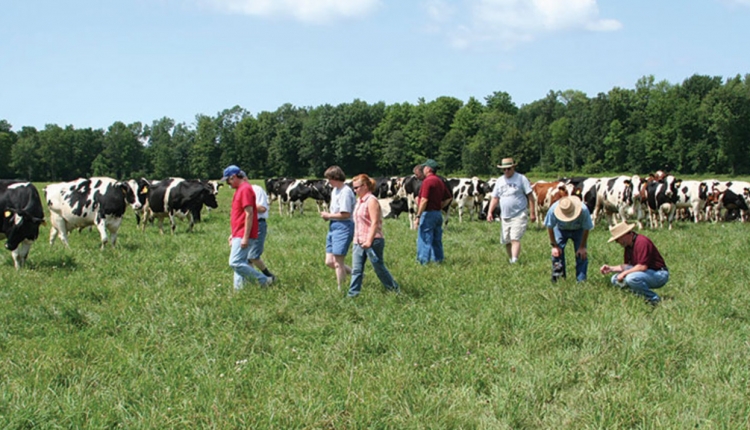Put a pasture walk on your to-do list |
| By Jim Gerrish |
|
|
|
The author is a rancher, author, speaker, and consultant with over 40 years of experience in grazing management research, outreach, and practice. He has lived and grazed livestock in hot, humid Missouri and cold, dry Idaho.  I was recently asked why my column was called “The Pasture Walk.” I asked the individual if he had ever been to a pasture walk, and the reply was, “No, what’s that?” I am sure many readers have had the experience of enjoying pasture walks on a regular basis, or at least attended one somewhere, sometime. There are other readers who probably have not had the pleasure of doing so, though. A pasture walk is a gathering of farmers and ranchers, usually on someone’s farm, where pasture, livestock, and grazing management are explored and discussed. In extension or educational jargon, a pasture walk would be described as either peer-based or lateral learning. That means rather than an instructor teaching a group of people, they are learning from one another. I have attended many pasture walks over the years in many different places dating back to the late 1980s. A Kiwi influence As grass-based dairying was beginning to take off in the U.S. in the 1980s, most dairy farmers had no idea how to set up a grazing cell or how to manage pastures. They didn’t know if lifelong confinement cows would even know how to graze a pasture. Grazing networks were formed around the U.S. In some cases, they were organized by extension agents, while others were formed spontaneously at the grassroots level. In all cases, grazing networks were about farmers learning from one another. Groups like this had existed in New Zealand under the label of “farm study groups” back into the 1970s. There was a lot of New Zealand influence in the early stages of the movement to grass-based dairying in the U.S. The study group concept was one of the spinoffs of Kiwi influence, and that led to the grazing network and pasture walk movement. When we lived in Missouri, I was both a university researcher and a grass farmer. At the height of the farm crisis of the early to mid-1980s, a small group of farmers in north central Missouri banded together to help one another weather the storm. That core group founded what became the Green Hills Farm Project (GHFP). Objectives of the group were to save their farms through creating healthier soils and grasslands while producing healthier and more sustainable pasture-based products. Grass-fed beef was at the top of the list as a direct marketed farm product. Pasture poultry and pasture pork were also being raised by members of the group. One of the activities of the GHFP was a pasture walk every Thursday afternoon followed by a potluck dinner. I was acquainted with all the farmers who formed the original core group. I was initially invited to join the group based on my role as a researcher at the University of Missouri Forage Systems Research Center. As time went by, I considered myself more of a producer member because I was probably learning more from the farmer-members of the group than they were learning from me. By the early 1990s, the group membership had swelled to well over 100 farms covering several northern Missouri counties. We hosted many pasture walks on our own farm over the dozen or so years we belonged to the group, which was up until the time we moved to Idaho in 2004. Lively conversation As the name implies, a pasture walk generally involves a stroll across the pastures. During the walk, the host will outline the general operation, specific management objectives, and challenges met. Anyone can ask questions or make suggestions to the host regarding what they are seeing and hearing. Sometimes there is a specific theme or issue the pasture walk will focus on. Occasionally, there might be a guest speaker. There is always a lively conversation among the group. This is the process of lateral learning where knowledge and experiences are shared to help all members of the group avoid the same pitfalls or learn about a new technique or tool they can take back to their own farm. In most cases, there is a communal meal associated with the event that allows further networking to develop. The GHFP in northern Missouri still holds their regular pasture walks monthly, now 37 years after the group’s founding. Many of the grazing networks formed in dairy regions are also still active. The sharing and learning process continues. I have been on pasture walks in many U.S. states, Canada, Mexico, Ireland, Australia, Falkland Islands, Mongolia, and other places around the world. In my experience and view, pasture walks are one of the best ways for farmers and ranchers to gain new knowledge. If you have never been to a pasture walk, I strongly encourage you to find the time to do so. It will be a learning experience. This article appeared in the April/May 2022 issue of Hay & Forage Grower on page 9. Not a subscriber? Click to get the print magazine. |
